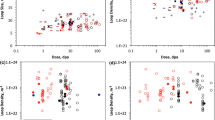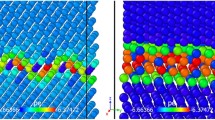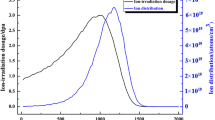Abstract
The dose rate effect significantly impacts accelerated assessment experiments of the radiation resistance of critical structural materials in nuclear reactors. This study investigated the role of the dose rate on the irradiation hardening and defect cluster formation in a low-Cu reactor pressure vessel (RPV) steel A508-3 under 3.5 MeV Fe13+ ions irradiation at 290 °C, with chosen dose rates of 2.8 × 10–5, 1.4 × 10–4 and 2.8 × 10–4 dpa/s. Nano-indentation and atom probe tomography (APT) techniques were employed to characterize the mechanical property changes and defect clustering behavior, respectively. Nanoindentation results revealed that for a fixed dose, greater hardening was observed in the sample irradiated at a lower dose rate, and conversely, less hardening at a higher dose rate. APT results for samples with 3.0 dpa demonstrated that defect clusters exhibited characteristics of small size and low density under irradiation at a dose rate of 2.8 × 10–4 dpa/s, and large size and high density at a dose rate of 2.8 × 10–5 dpa/s. The ratio of solutes to Fe elements in a cluster also varied with changes in dose rate. The change in hardening, cluster size, number density and cluster composition suggested that the evolution of defect clusters was primarily driven by ballistic mixing, rather than radiation-enhanced diffusion, under heavy ions irradiation within the dose rate range of 2.8 × 10–5–2.8 × 10–4 dpa/s.






Similar content being viewed by others
Explore related subjects
Discover the latest articles, news and stories from top researchers in related subjects.References
Odette GR, Lucas GE (2001) Embrittlement of nuclear reactor pressure vessels. JOM 53:18–22. https://doi.org/10.1007/s11837-001-0081-0
Shu S, Almirall N, Wells PB et al (2018) Precipitation in Fe–Cu and Fe–Cu–Mn model alloys under irradiation: dose rate effects. Acta Mater 157:72–82. https://doi.org/10.1016/j.actamat.2018.07.017
Kuleshova EA, Zhuchkov GM, Fedotova SV et al (2019) Precipitation kinetics of radiation-induced Ni–Mn–Si phases in VVER-1000 reactor pressure vessel steels under low and high flux irradiation. J Nucl Mater 553:153091. https://doi.org/10.1016/j.jnucmat.2021.153091
Belkacemi LT, Meslin E, Crocombette J-P et al (2021) Striking effect of solute elements (Mn, Ni) on radiation-induced segregation/precipitation in iron-based model alloys. J Nucl Mater 548:152807. https://doi.org/10.1016/j.jnucmat.2021.152807
Wagner A, Bergner F, Chaouadi R et al (2016) Effect of neutron flux on the characteristics of irradiation-induced nanofeatures and hardening in pressure vessel steels. Acta Mater 104:131–142. https://doi.org/10.1016/j.actamat.2015.11.027
Dubinko VI, Kotrechko SA, Klepikov VF (2009) Irradiation hardening of reactor pressure vessel steels due to the dislocation loop evolution. Radiat Eff Defects Solids 164:647–655. https://doi.org/10.1080/10420150903115743
Okita T, Sato T, Sekimura N et al (2002) The primary origin of dose rate effects on microstructural evolution of austenitic alloys during neutron irradiation. J Nucl Mater 307–311:322–326. https://doi.org/10.1016/s0022-3115(02)01202-3
Odette GR, Yamamoto T, Klingensmith D (2005) On the effect of dose rate on irradiation hardening of RPV steels. Philos Mag 85:779–797. https://doi.org/10.1080/14786430412331319910
Was GS (2015) Challenges to the use of ion irradiation for emulating reactor irradiation. J Mater Res 30:1158–1182. https://doi.org/10.1557/jmr.2015.73
Zinkle SJ, Snead LL (2018) Opportunities and limitations for ion beams in radiation effects studies: bridging critical gaps between charged particle and neutron irradiations. Scr Mater 143:154–160. https://doi.org/10.1016/j.scriptamat.2017.06.041
Boulanger L, Serruys Y (2009) Dislocation loops in Eurofer and a Fe–Cr alloy irradiated by ions at 350 and 550 °C at 3 dpa: effect of dose rate. J Nucl Mater 386–388:441–444. https://doi.org/10.1016/j.jnucmat.2008.12.150
Kamboj A, Almirall N, Yamamoto T et al (2024) Dose and dose rate dependence of precipitation in a series of surveillance RPV steels under ion and neutron irradiation. J Nucl Mater 588:154772. https://doi.org/10.1016/j.jnucmat.2023.154772
Reese ER, Almirall N, Yamamoto T et al (2018) Dose rate dependence of Cr precipitation in an ion-irradiated Fe 18Cr alloy. Scr Mater 146:213–217. https://doi.org/10.1016/j.scriptamat.2017.11.040
Hardie CD, Williams CA, Xu S, Roberts SG (2013) Effects of irradiation temperature and dose rate on the mechanical properties of self-ion implanted Fe and Fe–Cr alloys. J Nucl Mater 439:33–40. https://doi.org/10.1016/j.jnucmat.2013.03.052
Kedharnath A, Sarkar A, Kapoor R et al (2019) Irradiation studies on a reactor pressure vessel steel using Fe+ ion. Mater Res Express 6:1065c5. https://doi.org/10.1088/2053-1591/ab3f8b
Niu M, Wang H, Huang X (2023) Positron annihilation investigation of hardening behavior induced by Fe2+ irradiation in low-Cr FeCrAl alloys. J Mater Res Technol 24:7291–7301. https://doi.org/10.1016/j.jmrt.2023.05.005
Meslin E, Lambrecht M, Hernández-Mayoral M et al (2010) Characterization of neutron-irradiated ferritic model alloys and a RPV steel from combined APT, SANS, TEM and PAS analyses. J Nucl Mater 406:73–83. https://doi.org/10.1016/j.jnucmat.2009.12.021
Ando M, Tanigawa H, Kurotaki H, Katoh Y (2018) Mechanical properties of neutron irradiated F82H using micro-tensile testing. Nucl Mater Energy 16:258–262. https://doi.org/10.1016/j.nme.2018.07.008
Hosemann P, Shin C, Kiener D (2015) Small scale mechanical testing of irradiated materials. J Mater Res 30:1231–1245. https://doi.org/10.1557/jmr.2015.26
Wang R, Xu C, Liu X et al (2013) Microstructural and mechanical studies of reactor pressure vessel steel under proton irradiation. J Alloys Compd 581:788–792. https://doi.org/10.1016/j.jallcom.2013.07.149
Ding ZN, Han XX, Yang YT et al (2021) Characterization of microstructures and mechanical property of Fe-ion-irradiated China A508–3 steel. Nucl Instr Meth Phys Res B 504:14–20. https://doi.org/10.1016/j.nimb.2021.06.021
Ziegler JF, Biersack JP, Littmark U (1984) The stopping and range of ions in solids. Pergamon, New York
Hosemann P, Kiener D, Wang Y, Maloy SA (2012) Issues to consider using nano indentation on shallow ion beam irradiated materials. J Nucl Mater 425:136–139. https://doi.org/10.1016/j.jnucmat.2011.11.070
Nix WD, Gao H (1998) Indentation size effects in crystalline materials: a law for strain gradient plasticity. J Mech Phys Solids 46:411–425. https://doi.org/10.1016/s0022-5096(97)00086-0
Kasada R, Takayama Y, Yabuuchi K, Kimura A (2011) A new approach to evaluate irradiation hardening of ion-irradiated ferritic alloys by nano-indentation techniques. Fusion Eng Des 86:2658–2661. https://doi.org/10.1016/j.fusengdes.2011.03.073
Hunn JD, Lee EH, Byun TS, Mansur LK (2001) Ion-irradiation-induced hardening in Inconel 718. J Nucl Mater 296:203–209. https://doi.org/10.1016/s0022-3115(01)00519-0
Zhu X, Li Y, Wang R et al (2021) Effects of aging and irradiation on Fe–Ni–Al alloy. Nucl Instr Meth Phys Res B 509:55–59. https://doi.org/10.1016/j.nimb.2021.08.015
Zhao Y, Bhattacharya A, Pareige C et al (2022) Effect of heavy ion irradiation dose rate and temperature on α′ precipitation in high purity Fe–18%Cr alloy. Acta Mater 231:117888. https://doi.org/10.1016/j.actamat.2022.117888
Harrison RW, Carruthers AW, Hinks JA et al (2019) Cascade size and dose rate effects on α′ precipitation in ion-irradiated Fe14Cr alloy. Scr Mater 172:33–37. https://doi.org/10.1016/j.scriptamat.2019.06.034
Vincent E, Becquart CS, Domain C (2006) Ab initio calculations of self-interstitial interaction and migration with solute atoms in bcc Fe. J Nucl Mater 359:227–237. https://doi.org/10.1016/j.jnucmat.2006.08.022
Messina L, Schuler T, Nastar M et al (2020) Solute diffusion by self-interstitial defects and radiation-induced segregation in ferritic Fe–X (X=Cr, Cu, Mn, Ni, P, Si) dilute alloys. Acta Mater 191:166–185. https://doi.org/10.1016/j.actamat.2020.03.038
Chen C-L, Richter A, Kögler R, Talut G (2011) Dual beam irradiation of nanostructured FeCrAl oxide dispersion strengthened steel. J Nucl Mater 412:350–358. https://doi.org/10.1016/j.jnucmat.2011.03.041
Tan L, Busby JT (2015) Formulating the strength factor α for improved predictability of radiation hardening. J Nucl Mater 465:724–730. https://doi.org/10.1016/j.jnucmat.2015.07.009
Busby JT, Hash MC, Was GS (2005) The relationship between hardness and yield stress in irradiated austenitic and ferritic steels. J Nucl Mater 336:267–278. https://doi.org/10.1016/j.jnucmat.2004.09.024
Belkacemi LT, Meslin E, Décamps B et al (2020) Role of displacement cascades in Ni clustering in a ferritic Fe-3.3 at% Ni model alloy: comparison of heavy and light particle irradiations. Scr Mater 188:169–173. https://doi.org/10.1016/j.scriptamat.2020.07.031
Nelson RS, Hudson JA, Mazey DJ (1972) The stability of precipitates in an irradiation environment. J Nucl Mater 44:318–330. https://doi.org/10.1016/0022-3115(72)90043-8
Was GS (2007) Fundamentals of radiation materials science. Springer, New York
Heinig KH, Müller T, Schmidt B et al (2003) Interfaces under ion irradiation: growth and taming of nanostructures. Appl Phys A 77:17–25. https://doi.org/10.1007/s00339-002-2061-9
Levine SM, Pareige C, Jiao Z et al (2022) Phase instabilities in austenitic steels during particle bombardment at high and low dose rates. Mater Des 217:110588. https://doi.org/10.1016/j.matdes.2022.110588
Thomas KN, Was GS (2023) Effect of cascade size and damage rate on α’ precipitate stability in Fe–15Cr. J Nucl Mater 585:154615. https://doi.org/10.1016/j.jnucmat.2023.154615
Acknowledgements
This study is supported by the National Key Research and Development Programs of China (Grant No. 2022YFE03120001 and 2017YFB0702202). The authors gratefully acknowledge the operation team of the 320 kV platform for their help in the ion irradiation experiments.
Author information
Authors and Affiliations
Contributions
YTY provided investigation, conceptualization, calculation, data curation, analysis, writing original draft and funding acquisition; CHZ performed resources, methodology, project administration and funding acquisition; JG did the investigation, data curation and analysis; JYL gave, investigation, data curation and analysis.
Corresponding author
Ethics declarations
Conflict of interest
The authors declare that they have no known competing financial interests or personal relationships that could have appeared to influence the work reported in this paper.
Ethical approval
Not applicable.
Additional information
Handling Editor: Naiqin Zhao.
Publisher's Note
Springer Nature remains neutral with regard to jurisdictional claims in published maps and institutional affiliations.
Rights and permissions
Springer Nature or its licensor (e.g. a society or other partner) holds exclusive rights to this article under a publishing agreement with the author(s) or other rightsholder(s); author self-archiving of the accepted manuscript version of this article is solely governed by the terms of such publishing agreement and applicable law.
About this article
Cite this article
Yang, Y., Zhang, C., Gou, J. et al. The impact of dose rate on defect clustering and irradiation hardening in reactor pressure vessel steel under Fe ion irradiation. J Mater Sci 59, 1056–1067 (2024). https://doi.org/10.1007/s10853-023-09253-1
Received:
Accepted:
Published:
Issue Date:
DOI: https://doi.org/10.1007/s10853-023-09253-1




